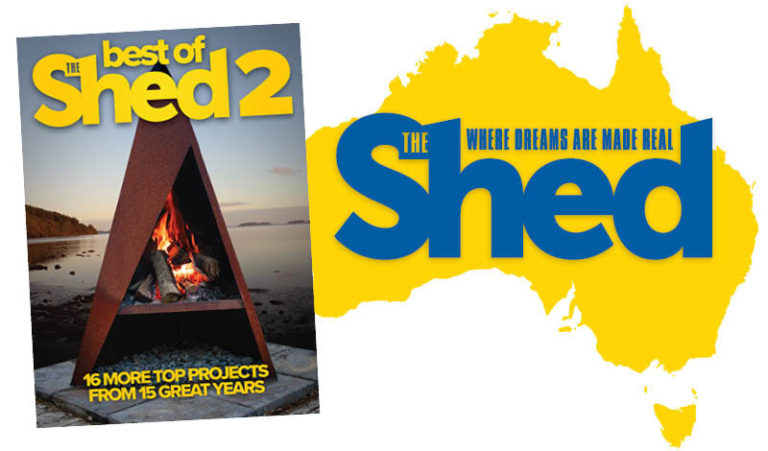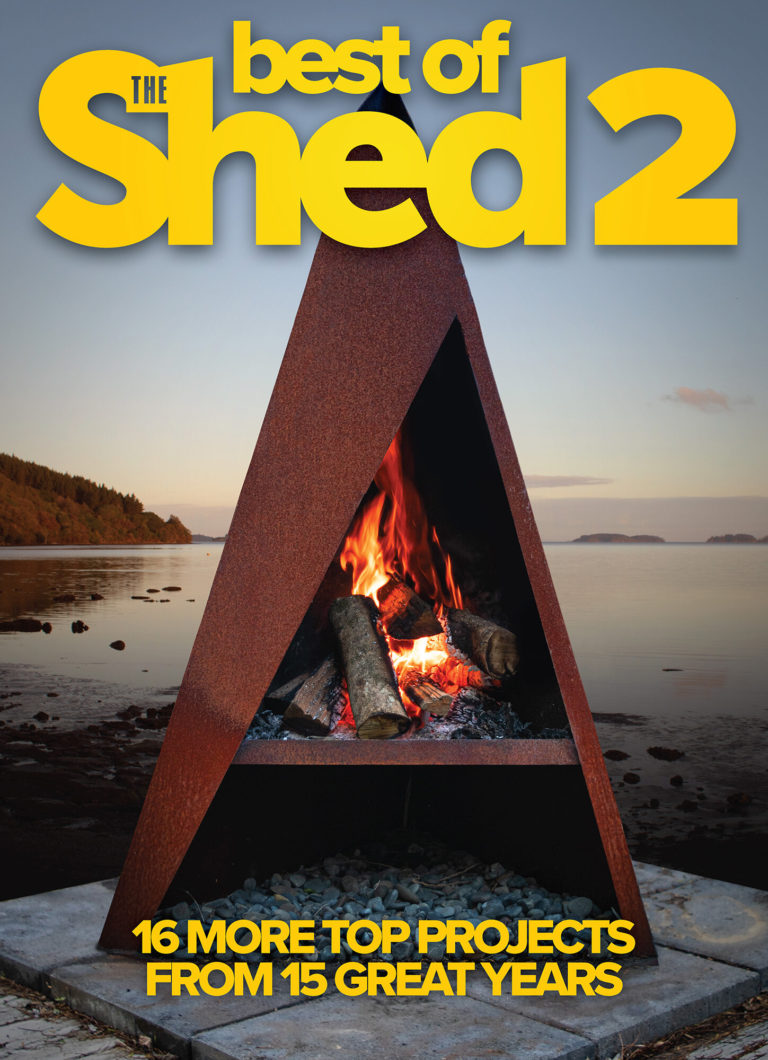Step by step through the casting process.
by Len Gale
Model traction engine with aluminium wheels
With my background as a fitter and turner with the railways, it was natural that I would be interested in making small then large wooden locomotives as presents or to sell and then extend this to creating a steam tractor, the traditional traction engine.
At one point, a friendly sheddie lent me his foundry equipment, a furnace, crucible and tongs etc and I melted down old pistons to get a fine-grained cast. Wheels are an important component to add character to a toy tractor, truck or loco. This raises the possibility of casting wheels in aluminium. Casting aluminium is not as complicated as it may seem; common sense is the main ingredient. In the case of a tractor or traction engine which has two small and two much larger wheels, the contrast between the sizes is important. Further, the large wheels need to be wide but have thin tapered spokes.
This poses a problem: how to flow enough molten metal through the spokes to fill the rim? One way that may succeed is to extend the length of the sprue, (entry port) to increase the weight of molten metal above the cavity. Another solution is to add a 5 mm backing on the pattern. Thus the spokes will be formed, as well as this “extra cavity” and the rim will fill too.
Patterns
Traditionally patterns have been made of close-grained wood. Metal and plastic patterns have advantages and now patterns can be generated on a 3D printer.
There are three types of pattern:
Split pattern. As the name suggests, this has two halves that align with two or more location-pins. Each half creates a cavity in the two parts of the mould. The two “boxes”—the cope (upper) and the drag—have location pins and corresponding holes that back up the location pins in the pattern (See drawing).
Core pattern. This is a split pattern that has a “print” that allows for the in-plant of a firm piece of sand that makes it possible to cast an object with internal shapes that could not be machined.
Single pattern. This makes a cavity in the cope. There is no need for location between the cope and the drag. The sand in the drag is smoothed off to form the back of the casting. The wheel being cast here is from a single pattern.
All patterns need taper (draft)—from one degree to five degrees—to assist in removal. Remember the tapered buckets on the beach, when we were kids? The sandcastle bucket was also tapped with a wooden spade to consolidate the damp sand and shell. If the mixture was too dry the sand crumbled, too wet and it slopped over. Dad knew what he was doing when he tapped the bucket.
A machining allowance may be needed and there is the question of shrinkage; for aluminium this is 3-4 percent, depending on the brew and the mass. A 150 mm wheel casting will have shrunk approximately 4 mm. Every wheel cast from that pattern will be a clone, not quite replicas of the pattern.
Pattern on sand with sprue rod in place.
Pattern imprinted.
Wheels
The wheels in this exercise are cast from metal patterns. Each pattern has a 10 mm hole in the centre to locate a tapered rod that will form the sprue. In our cast, the molten metal will go down the sprue hole to the cavity in the cope. Air will escape up the sprue as the metal flows in. Air will also escape into the sand and vents can be made with a thin wire around the rim. This method is direct and simple.
Note: The sprue can be located off to one side and a groove in the sand called a runner will deliver the molten metal to the cavity. On the other side of the cavity, a runner connects another hole called a riser. This allows air to escape as the mould fills and indicates a full cast as metal comes up the riser.
Ready for the pour
The furnace
Moulding sand
Casting metal into re-useable sand is called green-sand casting. In New Zealand, our natural-bonded sand comes from Green Island near Dunedin and just happens to be greenish in colour. Over time, it will darken as the clay is burnt out. Powdered clay will need to be added. When the sand is new, there should be about 20 percent clay in the mix. From being bone-dry, the sand is “tempered” by adding water sprinkled on with a watering can as the pile is turned over and over. It may take a few days before the clay locks in with the sand. A concrete mixer would help. When a handful of sand, firmly squeezed, holds its shape and can be snapped in half without falling apart, the sand is ready to meet the sieve.
The melt.
The mould
Place the drag on the moulding board. There are cleats under the moulding board so that the entire unit can be lifted to the area close to the furnace. Shovel in sand and ram it firmly. When the drag is nearly full, sieve in sand and “strike off” with a straight edge and float off smooth. Give this surface a good sprinkling of talcum powder or chalk dust. The dry powder provides a barrier between the two parts of sand, a parting line.
Fit the cope onto the drag. Put the pattern (in this case, a wheel) on the sand in the drag with the sprue rod in place. Use a kitchen sieve to cover the pattern with fine sand and firm the sand on and around the pattern with your fingers. Shovel in more sand to half fill the cope and ram it firmly with the tapered end of the wooden rammer. This wedges the sand in the cope.
Fill the cope and ram the sand with the flat end of the rammer and strike off.
Before you remove the sprue rod, cut a chamfer around the rod to make an entrance funnel. Remove the sprue rod. Firm the sand at the entrance with a finger. The cope can be lifted clear. The sand/clay mix remains firmly in the cope with half the pattern imprinted. The metal pattern itself, due to its weight, should be sitting on the sand in the drag. A wooden pattern will need help in the form of screws that can be gently tapped and then the pattern lifted free.
Before replacing the cope on the drag and assuming the melt is ready, give the cavity and sprue hole a brief touch of heat with a propane torch. This will harden the surface sand and ensure a smooth surface on the casting and blow out any loose sand. Alternatively, lightly spray on meths and ignite.
Readying the pour
Teamwork
First a dummy run with a helper. Set out the equipment step by step. Mime exactly each move you will both make. Enter de-gassing tablets into the melt. Lift the crucible from the furnace with the clamping tongs. Lower it onto the fire-bricks on which rests the lifting bar. The bar has a crank on one end and this controls the pour. The other end is straight and has a steel tube on it, so that the helper does NOT control the pour. Practise removing dross from the surface. Mime the pour and, in turn, mime pouring the surplus into the cast-iron gem trays. The main thing is to have everything to hand and to keep footwork to a minimum. Pivot rather than step.
Firing up
Be sure there is nothing in the furnace floor that will stick to the crucible. Place the crucible in the furnace with the spout lined up for the pour. Drop in small pieces of scrap to about a third.
Ignite, opening the valves to adjust the flame to neutral. Black smoke indicates an excess of fuel (carbon) and a loud roar means too much air (oxygen). Getting the pressure right is important. If it is too low, it will take forever to melt the metal. Too high and fuel will be wasted.
Once the metal has melted, add the scrap that has been pre-heating on the lid. Be sure the scrap is smaller than the inside diameter of the crucible. Large chunks, pre-heated, break easily with hammer blows. Keep the visor in the “down” mode.
The pour
Aluminium melts at around 650 °C. The melt has a smooth surface at this temperature. I thrust a thin willow branch in and give it a good stir to see that there are no lumps and to boil up the dross. The dross is best removed with a wooden scoop and transferred to a sand tray.
The moulds are set out in line within easy reach of the furnace as we do not carry molten metal around the shed.
There will be a faint crackling noise as the melt settles in the mould; steam forms as the damp sand heats up. Weights placed across the cope are good insurance as the cope could lift, allowing metal to escape. Allow plenty of time before you open the mould (this time will depend on the mass). Tip the sand into the bin through a garden sieve. Add a sprinkle of water and replace the lid. Hack-saw half way through the sprue near the wheel and snap it off.
There may be some flash around the rim that can be filed off. When the casting has had the surface cleaned up (fettled) and held in the reverse jaws of the three-jaw chuck, the metal behind the spokes is faced off with a round-nosed tool.
Brush on some kerosene. The rim and the boss gain 5 mm and the spokes look the part.
At this point a hole is centre-drilled then drilled and reamed 10 mm. A mandrel is fitted so that final machining is concentric to the bore. The mandrel is a machined 10 mm bolt with washers, a nut and a centre-drilled hole in the end. All four wheels are machined on this mandrel, keeping the two outside diameters the same. In practice, a large wheel and a small one were cast in the same flask.
Surplus poured into gem trays
Extended sprue (entry port) increases weight of molten metal.
New wheel and original pattern
De-gassing, flux
You may choose to use commercial de-gassing tablets or make your own. The de-gasser is potassium chloride sold as “Lo-Salt” at the supermarket. This chemical drives off the hydrogen. The flux is washing soda, sodium carbonate. This cleans the melt, forming dross and making the aluminium flow better. It is available at swimming pool suppliers as “pH up”. Both are used at about a teaspoonful for up to a 5 kg melt.
Wrap the powder in aluminium foil. Be sure to force the tablet to the bottom of the melt. Turn away from the fumes—all our casting is done in a well-ventilated area. Consider steel or brass, rather than aluminium for the axles as the same metals tend to fret (bind). Dome the ends. To hold the wheels on, machine grooves in the axles for cir-clips or drill the axles for split pins.
The sprue is hack-sawed then snapped off.
Wheels machined on mandrel, keeping both diameters the same
Fire warning!
Be sure you are not about to ignite a piece of magnesium, an aluminium look-alike. Try the vinegar test. If it fizzes, you have a fire hazard.
This drawing of a split pattern—with two halves that create cavities in the two parts of the mould—illustrates elements of sand casting. The wheel casting in the article above is a single pattern.


